

Top 15 Dry Ice Experiments: Super Cool & Fun
Spark your scientific curiosity and amaze your senses! We have collected 15 dry ice experiments that will produce exciting effects.
These experiments are not only educational but also kid-approved, which means that they are safe, simple to carry out, and will hold the interest of kids of all ages.
Kids can have fun and satisfy their curiosity while learning about the characteristics of dry ice, such as its sublimation process, through these experiments.
These dry ice experiments are likely to be a hit, whether you’re a teacher seeking for classroom activities or a parent looking for a fun weekend project.
Remember, it’s important to remember that dry ice can be dangerous if not handled properly.
Adult supervision is necessary to ensure that all safety precautions are followed and to prevent accidents or injury. By working together and taking the necessary precautions, you can safely and responsibly conduct dry ice experiments and create an exciting learning experience for everyone involved.
Okay, now put on your safety glasses and gloves and let’s get started!
1. Mad Scientist Potion
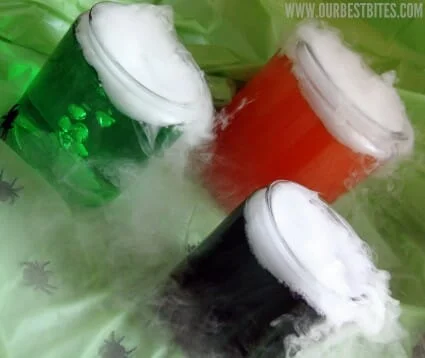
Trying Mad Scientist potion experiments can be a great way to engage children in science and encourage their curiosity and creativity. These experiments are designed to be safe and fun, allowing kids to explore scientific principles in a hands-on way that is both educational and entertaining.
Get ready to brew up some fun with this Mad Scientist potion experiment that’s both safe and exciting for kids!
Learn more: Mad Scientist Potion
2. Smoking Dragon Science with Dry Ice
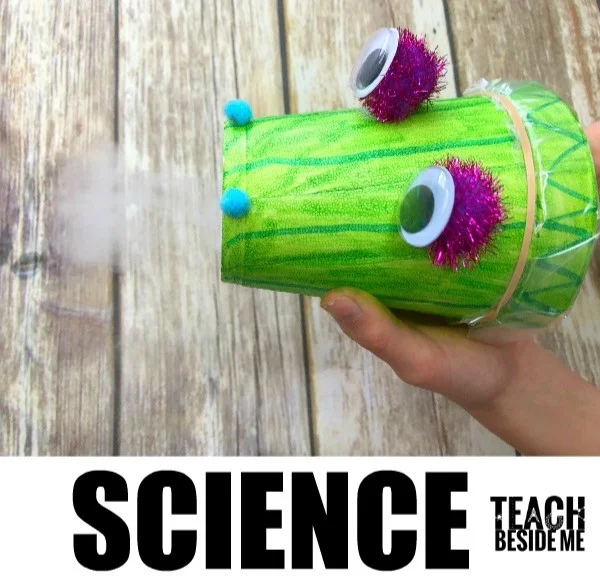
Smoking Dragon Science with Dry Ice is a fascinating and exciting way to explore the unique properties of solid carbon dioxide. With its ability to create a cool, fog-like effect, dry ice is perfect for creating the illusion of a smoking dragon.
This type of experiment is not only visually captivating but can also help teach principles of science, such as the sublimation process and states of matter. Unleash the power of the Smoking Dragon with these thrilling science experiments using Dry Ice!
Learn more: Smoking Dragon Science with Dry Ice
3. Dry Ice Rockets

The dry ice rockets experiment is a fantastic exercise for kids since it is entertaining and educational. It is an excellent approach to teach children about chemical reactions, pressure, and sublimation in a fun and interactive way.
Learn More: Dry Ice Experiment
4. Ghostly Boo Bubbles

The Ghostly Boo Bubbles Experiment is an entertaining and educational game that may teach kids about scientific concepts while they are having fun. It is a fantastic approach to capture children’s curiosity and motivate them to discover what’s happening around them.
Learn more: Ghostly Boo Bubbles
5. Make Dry Ice Balloon

The Ice Dry Balloon experiment is a fantastic approach to show children the scientific method and emphasize the value of making observations and coming to conclusions based on data. In a science journal, they can write down their observations, place questions, and make predictions.
Learn more: How to Make Dry Ice Balloon
6. Frozen Bubbles

The frozen bubbles experiment is a visually spectacular technique to teach kids about scientific ideas in a playful and interesting way. It can aid in their comprehension of the characteristics of water and how they alter while freezing, as well as the mechanism of sublimation and how it relates to dry ice and other substances.
Learn more: How to Make Frozen Bubbles
7. Home Made Root Beer with Dry Ice
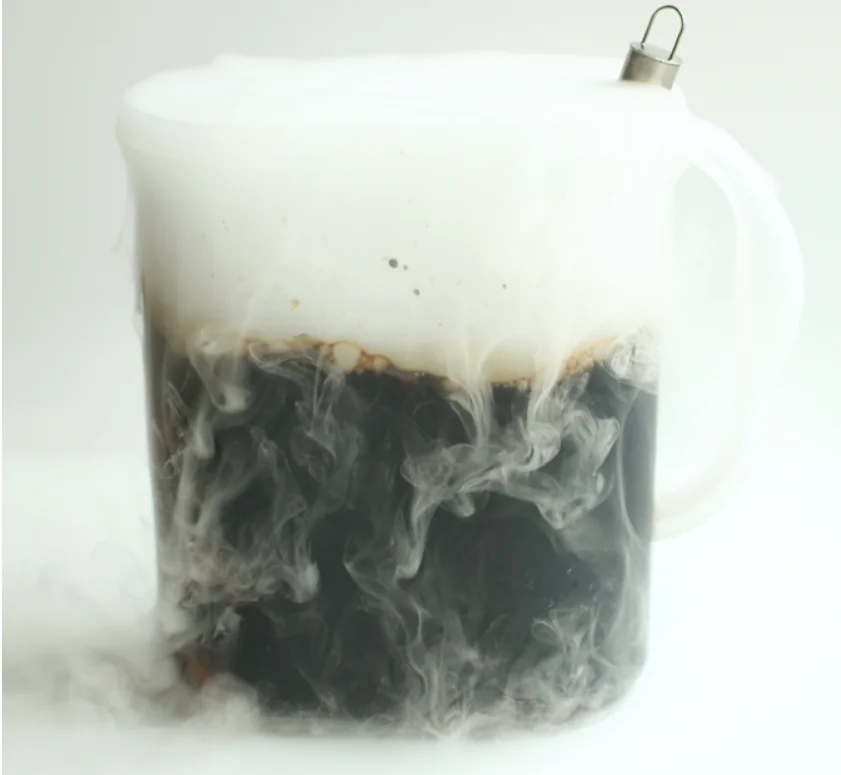
By performing this experiment, you may discover more about the characteristics of dry ice and how it turns into gas when it is exposed to room temperature. The process of fermentation, which is used to make carbonated drinks like root beer, is another topic you might explore.
Learn more: Home Made Root Beer Recipe
8. Make Ice Cream

Another excellent method to learn about the principles of phase shifts and the characteristics of dry ice is to make ice cream with it. Teaching kids about the wonders of science can be a fun and interactive experience.
Learn more: Like Magic: Make Ice Cream with Dry Ice!
9. Inflate a Balloon
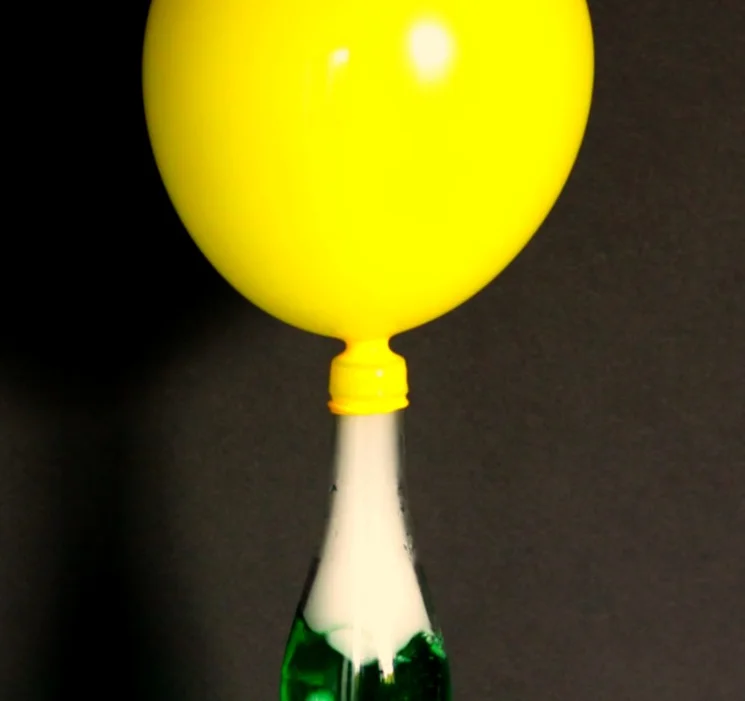
The process of inflating a balloon using dry ice can be an educational and engaging way to teach children or students about the properties of dry ice and how it sublimates from a solid to a gas.
Learn more: Inflate a Balloon
10. Dry Ice Soda Geyser
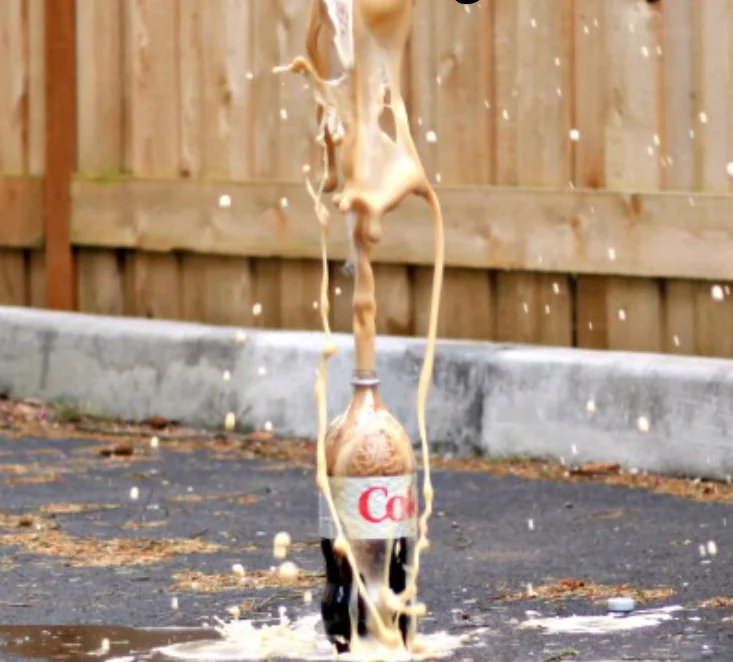
The experiment can also be an educational opportunity to learn about gas pressure and carbonation. It can help to illustrate the process of phase changes and the release of gases from carbonated beverages.
Learn more: Dry Ice Soda Geyser Experiment
11. Watermelon Dry Ice Explosion

In this experiment, dry ice is combined with watermelon to create a powerful impact or explosion that will surely take your breath away.
Learn more: Watermelon Dry Ice Explosion
12. Dry Ice Color Changing Liquid
Dry ice color changing experiments can be a fun and educational activity for kids. This experiment involves adding dry ice to water mixed with a pH indicator, which changes color as the dry ice reacts with the water.
Learn more: Dry Ice Color Changing Liquid
13. Dry Ice Boat
This experiment is not only fun but also a great way to teach kids about the properties of dry ice and how it interacts with water. Concepts like buoyancy, gas pressure, and chemical reactions can be explained in an interesting and practical way.
14. Dry Ice Bubble Tower
The dry ice bubble experiment demonstrates how dry ice can go from a solid to a gas (sublimation) when it is exposed to room temperature. This is a great way to teach students about the different states of matter and how they can change from one to another.
15. Dry Ice Bomb
The dry ice bomb experiment is a popular activity that involves creating a chemical reaction using dry ice and water inside a sealed container. The reaction produces a build-up of gas pressure inside the container, leading to an explosive release of gas and a loud popping sound.
Similar Posts:
- Top 100 Fine Motor Skills Activities for Toddlers and Preschoolers
- 37 Water Science Experiments: Fun & Easy
- 68 Best Chemistry Experiments: Learn About Chemical Reactions
Leave a Comment Cancel reply
Save my name and email in this browser for the next time I comment.
- Science, Tech, Math ›
- Chemistry ›
- Projects & Experiments ›
Cool Dry Ice Experiments
14 Projects Using Solid Carbon Dioxide
- Projects & Experiments
- Chemical Laws
- Periodic Table
- Scientific Method
- Biochemistry
- Physical Chemistry
- Medical Chemistry
- Chemistry In Everyday Life
- Famous Chemists
- Activities for Kids
- Abbreviations & Acronyms
- Weather & Climate
- Ph.D., Biomedical Sciences, University of Tennessee at Knoxville
- B.A., Physics and Mathematics, Hastings College
Dry ice is extremely cold, plus it's also cool! There are many interesting and educational dry ice experiments and projects to try.
Dry ice , the solid form of carbon dioxide isn't dangerous if stored and used correctly. If dry ice is not properly stored, it can present hazards such as frostbite , asphyxiation, and the possibility of an explosion . So be careful and have fun!
Here are several dry ice experiments for you to try:
Cool Dry Ice Fog
One of the simplest yet coolest things to do with dry ice is to toss a chunk of it into a container of hot water. This causes the dry ice to sublimate (turn into vapor) more quickly, producing dry ice fog. This is a popular party effect. It's even more spectacular if you have a lot of dry ice and plenty of water, such as enough dry ice to fill a hot tub.
Dry Ice Crystal Ball
CasPhotography / Getty Images
Place a piece of dry ice in a bowl or cup containing a bubble solution. Wet a towel with bubble solution and pull it across the lip of the bowl, trapping carbon dioxide into a giant bubble that resembles a crystal ball .
Make Your Own Dry Ice
waraphorn-aphai / Getty Images
Some grocery stores sell dry ice, but many don't. If you can't find any dry ice, the first cool thing to do is to make some yourself.
Frozen Soap Bubble
Freeze a soap bubble over a piece of dry ice. The bubble will appear to float in the air over the dry ice. You can pick up the bubble and examine it.
Inflate a Balloon With Dry Ice
Seal a small piece of dry ice inside a balloon . As the dry ice sublimates, the balloon will fill up. If your piece of dry ice is too big, the balloon will pop!
Inflate a Glove With Dry Ice
~UserGI15632523 / Getty Images
Similarly, you can put a piece of dry ice into a latex or other plastic glove and tie it closed. The dry ice will inflate the glove.
Simulate a Comet
Jonathan Blair / Getty Images
You can use simple materials to simulate a comet . In a big plastic bowl lined with a trash bag, mix together:
- 1-liter water
- 2 cups dirt
- 1 tablespoon starch (holds comet together, not found in real comets)
- 1 tablespoon syrup (comet organic component)
- 1 tablespoon vinegar (for amino acids )
- 1 tablespoon rubbing alcohol (like the methanol in real comets)
Dry Ice Bomb
waraphorn-aphai / Getty Images
Sealing dry ice in a container will cause it to burst. The safest version is to place a small piece of dry ice into a plastic film canister or potato chip can with a pop lid.
Dry Ice Erupting Volcano Cake
JennyPPhoto / Getty Images
While you can't eat dry ice, you can use it as a decoration for food. In this project, dry ice produces a volcanic eruption for a volcano cake.
Spooky Dry Ice Jack-o'-Lantern
joeygil / Getty Images
Make a cool Halloween jack-o'-lantern that spews dry ice fog.
Cool Dry Ice Bubbles
Amrut Kulkarni / Getty Images
Place a piece of dry ice into a bubble solution for fog-filled bubbles to form. Popping them releases dry ice fog , which is a cool effect.
Carbonated Dry Ice Ice Cream
RossHelen / Getty Images
You can use dry ice to make instant ice cream . Because carbon dioxide gas is released, the resulting ice cream is bubbly and carbonated, like an ice cream float.
Singing Spoon
Pakorn Kumruen / EyeEm / Getty Images
Press a spoon or any metal object against a piece of dry ice and it will appear to sing or scream as it vibrates.
Carbonated Fizzy Fruit
Castle City Creative / Getty Images
Freeze strawberries or other fruit using dry ice. Carbon dioxide bubbles become trapped in the fruit, making it fizzy and carbonated.
- 10 Cool Chemistry Experiments
- Where to Buy Saltpeter or Potassium Nitrate
- Cool Things to Do With Dry Ice
- 5 Ways to Make Glue
- How to Grow Table Salt or Sodium Chloride Crystals
- 10 Amazing Chemical Reactions
- How to Make Non-toxic Dry Ice Smoke or Fog
- Equation for the Reaction Between Baking Soda and Vinegar
- Homemade Dry Ice Recipe
- Cool Halloween Jack o Lanterns
- Make Frozen Bubbles
- Spooky Halloween Jack-o-Lantern
- Vitamin C Determination by Iodine Titration
- Halloween Chemistry Demonstrations
- Top Halloween Chemistry Projects
- Fun Bubble Science Projects

The Homeschool Resource Room
creative ideas, practical advice, genuine support

10 Incredible Dry Ice Experiments for Kids!
This post may contain affiliate links. See our disclosure policy for details.
Try these amazing dry ice STEM activities for kids ! Science experiments and projects that will make your kids say, “WOW!!!!”

If your science routine has become a little hum drum, it might be time to liven things up. And nothing gets the Ooooooos and Ahhhhhhs quite like dry ice!
Dry ice is an amazing material to experiment with. You can create everything from magical fog to strange, frozen bubbles. Below I’ve collected ten of our favorite dry ice experiments for you to try with your kids, class, or co-op group!
Tips for Dry Ice Experiments
Before you begin, make sure to familiarize yourself with a few safety tips for working with dry ice . Experiments should be monitored from start to finish and whenever the dry ice is accessible.
If you’re buying a hunk of dry ice, it’s good to have a couple experiments lined up so you can use it before it disappears. So pick a few things and get those materials set up before you bring the ice home. You can usually find dry ice in the freezer section of your grocery store.

1. Dry Ice Soda Geyser by Science Kiddo
2. smoking bubbles dry ice experiment by raising dragons, 3. make frozen bubbles by though co., 4. watermelon dry ice explosion by thrifty fun, 5. coin in dry ice experiment by ifl science, 6. mad scientist potion by our best bites, 7. harry potter crystal ball: dry ice experiment by teach beside me, 8. homemade root beer with dry ice by paintbrushes and popsicles, 9. make ice cream with dry ice by pop shop america, 10. inflate a balloon: cool dry ice experiments by science kiddo.

Ashley helps parents who want to homeschool find the resources they need to successfully teach their children. Ashley is a former teacher, current homeschooler, published author, and designer behind Circle Time with Miss Fox printables as well as the creator of this website, The Homeschool Resource Room.
Discover more from The Homeschool Resource Room
Subscribe now to keep reading and get access to the full archive.
Continue reading

Dry Ice Experiments Your Students Will LOVE!
Inside: If you’ve been wanting to try dry ice with your students but aren’t sure where to start, you’ll learn about my favorite dry ice demo, dry ice station lab ideas, how to store it, and safety precautions for using dry ice.
Have your students ever explored the phenomenon of sublimation ?
Sublimation is the process of changing from the state of a solid to a gas.
If you’re ready to take your classroom to a new level of excitement, keep reading!
Every year I look forward to the Sublimation Stations lab with dry ice !
There are so many ways to integrate it into the curriculum! It’s a fun way to extend a matter unit . This station inquiry is also a great way for students to practice writing a hypothesis and making observations !
The end of October is always fun for this lab! It is a great way to “celebrate” Halloween in middle school without candy, costumes, or a party.
This lab IS THE PARTY!
Don’t forget to pin this for later!
Dry ice candle demonstration.
An awesome way to introduce sublimation is with the candle demo .
DEMO INSTRUCTIONS
- Pour several pieces of dry ice into a beaker.
- Show the students a lit candle and ask them to make a hypothesis about what will happen when you “pour” the dry ice onto the candle.
- As your students watch the demo, they will observe that the flame will go out.
- They will also observe that the vapor coming off of the cup goes down, unlike hot steam, which rises.
- This is due to the temperature difference and the density of the CO 2 gas which is heavier than air. Also, it does not provide oxygen for combustion.
- After discussing this dry ice experiment with your class, I like to let them loose with the sublimation stations.
Dry Ice Inquiry-Based Activities for Kids
I have created a set of six inquiry-based dry ice stations for students to explore .
These dry ice experiments are a great way for your students to practice following simple instructions, making a hypothesis, and writing observations.
Each station investigates dry ice using commonly found household objects (such as a popsicle stick, balloon, dish soap, and a penny).
Before each lab, students read directions and write a hypothesis. As they conduct each investigation, they write observations from the lab.
Students work in small groups to complete the following lab stations:
I also encourage my students to write an explanation for “why” the dry ice behaves that way to encourage them to think about the “science” behind the fun!
Early finishers love to design their own dry ice experiment – teacher-approved, of course!
Dry Ice Safety Precautions
- Use tongs to handle dry ice.
- Do not hold the dry ice in your hand for a long period of time. Touching it for a second or two will not hurt, but if you try to hold it, it can freeze your skin and feel like a burn.
- Never put dry ice into a closed glass container.
- Do NOT put dry ice into your mouth.
- Use appropriate eyewear.
Tips for purchasing and storing dry ice:
- It’s all in the planning! Since dry ice “melts” over time, it’s best to get it as close as possible to when you will be using it. Store the dry ice in an insulated cooler. Be sure to keep the lid on top until you need to remove pieces for the activity. If there is space in the cooler, you may want to pack it with newspapers to insulate it and help it last longer.
- Slab vs. Pellets—Pellets can be easier to handle for activities, but they tend to “disappear” faster if you don’t use them quickly enough.
- You can often find dry ice at your local Kroger. Walmart and Costco often have dry ice as well. It’s best to call ahead and pick it up the morning you use it.
- Often fundraisers (such as cookie dough) are shipped in dry ice. Our science department fights over every shipment – it’s free fun!
Sublimation Stations Inquiry Lab

In this resource, you’ll find:
- Dry Ice Background Information
- Materials list (household items)
- Dry Ice Demo Directions
- Explanation of each phenomenon for teachers
- 6 directed stations
- 1 design your own experiment station
- Student handout
- Black and white version for ease of printing

Still have questions about dry ice in the classroom?
Check out this post, “Dry Ice for Science Experiments – Everything You Need to Know.”
Similar Posts

Printable Holiday Cards, A Simple Way to Show Your Appreciation

5 Benefits of Switching to Digital Science Fair Boards

9 Awesome Holiday Gifts for Science Lovers

4 Phases of the Moon Worksheets and Activities Students Love

5 Ways to Use Task Cards in Middle School

A Teacher’s Guide to Survive (and Enjoy) Holidays in the Classroom
- Activities for Kids
10 Totally Cool Dry Ice Experiments for Kids

Frozen carbon dioxide, a.k.a. dry ice, is frozen at a temperature of negative 109 degrees Fahrenheit
Experimenting with ice is cool. But dry ice experiments are even cooler! Unlike the ice cubes in your freezer, dry ice doesn’t melt into liquid. Instead, these blocks sublimate, which means instead of transforming from a solid to a liquid, dry ice goes from a solid to a gas. With the proper precautions, this type of science experiment for kids is safe—so g rab gloves and tongs, open a window or take the CO2 outdoors, follow these guidelines from the National Weather Service, and check out these awesome dry ice experiments.
Blow Up a Balloon

The air from your lungs isn’t the only way to blow up a balloon. This chilly experiment from Science Kiddo helps your budding scientist explore the properties of dry ice.
Build a Volcano
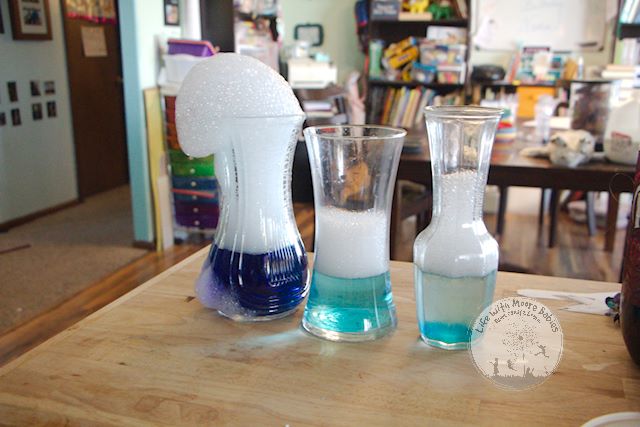
Check out this awesome overflowing dry ice volcano experiment from Life with Moore Learning ! As if this isn’t enough fun, you'll also get a step-by-step guide to help your kids compare regular ice with dry ice and other freezing explorations.
Plan a Potion

Whether you want to make a witch’s brew for your family's Halloween monster bash or you just want to mix up a cool (literally) concoction, Our Best Bite’s Mad Scientist Potion has everything you need to make a mocktail that’s overflowing with fog.
Related: 70+ Easy Science Experiments for Kids to Try at Home
Find Fog—Magically

Make your own at-home outdoor fog machine with two ingredients—dry ice and hot water. Remember, dry ice doesn’t melt into a liquid. Instead, it sublimates or turns into a vapor. Place blocks of dry ice into a glass or bucket of hot water and then stand back and watch as the fog pours across your yard!
Put Out a Candle

Can dry ice help extinguish a candle quickly? Your littles can easily blow out their bday cake candles, but have they ever used dry ice to make a flame go away? Head over to Life with Moore Learning for the how-to steps to this easy science exploration.
Make a Bubble Ball

How can your kids make a crystal ball? Gather a few pieces or pellets of dry ice, a bowl, dish soap and a kitchen towel. Put the dry ice into the bowl, add hot water and watch the fog show begin. Even though this is exciting, it’s not where the experiment ends. Dip the dish towel into a soapy solution, and spread it around the rim of the bowl. Gently pull the soap-soaked towel across the bowl and watch as a ball-like bubble emerges in front of your eyes.
Compare and Contrast

How does dry ice melt? The answer isn't regular ice. While you might already know this, your child doesn’t. Freeze water, juice, soda, milk, and any other liquid you want. Put the frozen liquid cubes on plates and create a comparison plate with dry ice. Watch each ice option carefully. Your child can jot down what happens to each piece of ice and when.
Related: It’s Alive! Gross (But Cool) Science Experiments for Kids
Inflate a Glove

If you have boxes of plastic or latex gloves hanging around your home, forget about cleaning. It’s time to put these gloves to scientific use, as they are a great substitute for balloons. Drop a shred of dry ice into the glove, tie the end and watch it magically grow. Hint: Don’t use too much dry ice for this experiment. A pellet will do. Overdoing it with the frozen CO2 might create too much gas, causing the glove to burst.
Bubbles and More Bubbles

You’ve covered dry ice with water and watched it fog. But what happens if you put the frozen CO2 into a bath of bubbles? Use your kiddo’s paddling pool or fill the sand table with a water and bubble solution or dish soap mix. Ask your child to predict what will happen as the dry ice sublimates. Observe the bubbles as the CO2 gas fills the water and moves into suds.
Magical Disappearing Ice

When regular ice melts it leaves behind a puddle, but the same isn't true for dry ice. Again, the sublimation process causes it to turn into a gas state. Help your child learn more about the states of matter with easy observation-based science exploration. Place a piece of dry ice in a bowl outside on a warm day or in the sun. Ask your child to predict what they think will happen to the dry ice. Go back later in the day and take a look at the bowl. Like magic, the ice is gone, and nothing is left behind. Discuss what happened. Your child can hypothesize where the ice went and why there is no water in the bowl.
Related: 6 Incredibly Easy Rainbow Science Experiments
Need some fresh ideas?
Subscribe to our weekly newsletter for expert parenting tips and simple solutions that make life instantly better.
By subscribing you agree to Tinybeans Terms and Privacy Policy
Related reads

Why Are Gen Z Kids Covering Their Noses in Family Photos?

Screen Time for Babies Linked to Sensory Differences in Toddlerhood, Study Shows

Kids Shouldn’t Have to Finish Dinner to Get Dessert, Dietitian Explains

The Questions Parents Should Be Asking Their Pediatrician—but Aren’t

6 Better Phrases to Say Instead of ‘Be Careful’ When Kids Are Taking Risks
- your daily dose

- and connection

- Your daily dose


IMAGES
VIDEO
COMMENTS
This experiment is not only fun but also a great way to teach kids about the properties of dry ice and how it interacts with water. Concepts like buoyancy, gas pressure, and chemical reactions can be explained in an interesting and practical way. 14. Dry Ice Bubble Tower.
CasPhotography / Getty Images. Place a piece of dry ice in a bowl or cup containing a bubble solution. Wet a towel with bubble solution and pull it across the lip of the bowl, trapping carbon dioxide into a giant bubble that resembles a crystal ball.
Mad Scientist Potion by Our Best Bites. 7. Harry Potter Crystal Ball: Dry Ice Experiment by Teach Beside Me. 8. Homemade Root Beer with Dry Ice by Paintbrushes and Popsicles. 9. Make Ice Cream with Dry Ice by Pop Shop America. 10. Inflate a Balloon: Cool Dry Ice Experiments by Science Kiddo.
Pour several pieces of dry ice into a beaker. Show the students a lit candle and ask them to make a hypothesis about what will happen when you “pour” the dry ice onto the candle. As your students watch the demo, they will observe that the flame will go out. They will also observe that the vapor coming off of the cup goes down, unlike hot ...
Dry ice science experiments for all ages of kids: I used to teach middle school, and I would do a series of dry ice experiments like this one with my students every year. It was one of their favorite days. I created the instruction sheet for this set of dry ice science experiments so that they could be done with kids of any age.
Gather a few pieces or pellets of dry ice, a bowl, dish soap and a kitchen towel. Put the dry ice into the bowl, add hot water and watch the fog show begin. Even though this is exciting, it’s not where the experiment ends. Dip the dish towel into a soapy solution, and spread it around the rim of the bowl.
Blow up a balloon using dry ice. First, put a few pieces of dry ice into the bottle. Then quickly put the opening of the balloon over the mouth of the bottle. The gas released as the dry ice sublimates will begin to blow up the balloon. When the balloon is fully inflated, take it off of the bottle and tie the end.
Make a Giant Dry Ice Bubble Crystal Ball using dry ice and water. Capture a Cloud in a Bag and then pour it out. Blow Bouncing Smoke Bubbles you can bounce in your hands from Steve Spangler Science. Suck a Balloon into a Bottle. Tap into your inner artist by creating vibrant Bubble Paintings with Dry Ice. Make a Bubble Volcano the kids can touch.
You need a bowl or wide-mouthed jar or vase. Use your tongs to place a chunk of dry ice into the container. Use a measuring cup or simply a drinking glass with warm water. Pour the warm water into the container with dry ice. Watch what happens, examine, and take notes. If the “smoke” dies, add more warm water.
Fill the bottle half way with warm water. Dip the unattached end in dishwashing liquid. Add ½ cup of dried ice. Replace the lid forcing the escaping carbon dioxide into the pipe forming “white egg shaped bubbles”. Remove the lid when the bubble is “egg sized” stopping the flow of carbon dioxide.